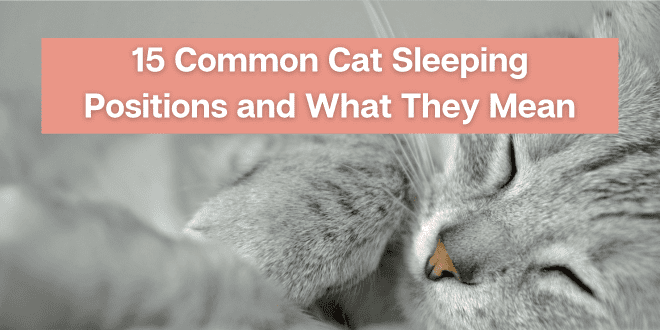
Who can resist the cuteness of a sleeping cat? Watching a cat who is sound asleep can bring such peace and calm, no matter what chaos may be happening around you, or whatever chaos that very cat may have created moments before.
Cats often look extremely comfortable while sleeping, but there are times when it’s baffling to imagine how they could possibly manage to relax in that scrunched position or while perilously perched atop a narrow object. Have you been curious about what some sleeping positions might indicate, or why a cat chooses a particular place to nap?
When looking at sleeping postures, you’ll need to consider the cat’s normal disposition, as well as the circumstances and environment, but here are some general interpretations.
1. Curled up in a Ball
This is likely the position you often see when it comes to cat naps. The cat curls into a ball with the tail wrapped around the body. This position is helpful in conserving heat and is the sleeping position seen frequently when temperatures drop. This posture is also protective, as it provides safety for vulnerable vital organs. Being curled up lets the cat appear small. A cat sleeping outdoors is at risk of potential ambush so it’s important to go unnoticed.
For an indoor cat, this popular position may be an indication he would like to remain undisturbed. Depending on the indoor temperature, it could also be a sign the cat is just trying to stay warm.
2. Belly up
Stretched out with the abdomen in full view typically says the cat is totally relaxed and doesn’t feel vulnerable. This position exposes the vital organs so it’s a sign of trust and security.
In this position, the cat should be able to relax and not be startled by an approaching family member who is unable to resist the urge to pet that soft tummy. Although some cats tolerate and may even enjoy belly rubs (most don’t though), it’s not a good idea to startle your sleeping cat and possibly trigger a defensive reaction. You’ll also potentially damage the trust you worked hard to establish.
3. Meatloaf
Cats in this position resemble a meatloaf. This is also referred to as the loaf position, perhaps because it resembles a load of bread.
In this position, the cat rests with front legs folded under the chest. This a common posture for light catnaps so the cat can be ready to spring into action if needed. There’s a modified meatloaf posture as well, where the front limbs aren’t folded, but just perched under the chest. This allows the cat to react even more quickly.
4. Sideways Sleeper
As with the belly up position, this posture usually indicates the cat feels secure enough to be in a vulnerable position. The vital organs are not as exposed but are still somewhat unprotected. A cat in a side sleeper position is probably in a deep sleep.
This position can also be related to the current temperature in the environment. The cat may be trying to stay cool by stretching out.
5. Eyes Barely Closed
Have you ever been concerned about your safety or needed to stay aware of your surroundings while trying to fall asleep? Maybe you’ve had to sleep with one eye open, so to speak. A cat is all too familiar with that situation. The cat’s eyes may be just slightly open or there will be one open and one closed. This is not a deep sleep position, but more of a resting, light cat nap.
In this position, the cat is keeping tabs on potential activity in the environment, such as the opportunity to pounce on prey or the need to escape a sudden threat. You may notice the eyes open periodically and then slowly close again, or maybe you’ll see some accompanying ear movement.
This position lets the cat get some rest while remaining on guard.
6. Paw Over the Face
The cat is probably in a deeper sleep and doesn’t want to be disturbed. The paw covering the face may be for a little extra protection. It may be the cat’s version of a sleep mask.
7. Dangling Legs
If the cat is sleeping on an elevated location with one or more limbs dangling, it’s likely an indication of total relaxation and feeling safe. Being on the elevated spot may create a feeling of security, which leads to relaxation.
If the cat is on a cat tree perch with limbs hanging down, make sure the reason isn’t because the perch is too small. During in-home consultations, I’ve seen very large cats trying to position themselves on perches that were way too small.
8. Yoga Master
The cat’s extremely flexible spine comes into play in many sleeping positions. This twisted torso position seems impossible to imagine as comfortable, but a cat always makes it look easy and relaxing.
What does this contortionist’s sleeping position mean? Maybe cats do it just because they can.
9. Perched on the Edge
When a cat sleeps on the very edge of an object, such as a railing, table, sofa, or chair, it could mean kitty is ready to bolt, if needed. Perching on the edge may also give the cat a better ability to watch over the area.
10. Sleeping in a Box
Cats love boxes, whether for playing, hiding, or sleeping. The box offers concealment. When sleeping, this may provide a little extra protection. A cat may also feel more secure having his back up against something. This may offer a little reassurance that he won’t get ambushed from behind. Being in a box is also a way to get a little extra warmth.
11. Cuddled Near or on Top of You
This position pretty much speaks of affection, trust, and bonding. Sleeping near or on you is just one of the many ways cats show love. Your close presence can also be a source of security, especially if the cat is afraid or unsure. A cat may also enjoy the bonus of the extra warmth generated by cuddling up with you.
By the way, don’t be insulted if a cat chooses to sleep with his back to you. It’s not that your cat is ignoring you. This position is a sign of trust.
12. Sleeping Close to Other Pets
This is a strong indication of a close bond. In multicat environments, it’s usually easy to identify the cats who have close bonds because they will often sleep together. Snuggling close together is also beneficial for warmth and protection.
13. Sleeping on Your Head
There may be several reasons for this position. A cat often seeks warmth when sleeping and your head is good source of heat. The attraction to sleeping on your head may also be due to the appealing and familiar scent of your hair. Since cats are so scent-focused, it’s a great way to be as close to your comforting scent as possible.
Your pillow may also be the reason your cat cuddles up around your head. In addition to the bonus of a familiar scent, your pillow is very soft and comfortable.
There’s also the possibility that your cat has learned from experience that being so close to your head is a good way to get your attention when it gets close to breakfast time.
14. Under the Covers
Cats love warmth. They also take comfort in familiar, friendly scents. Your bed provides the security of containing your scent as well as being a warm and soft place for a nap. A cat may burrow under the covers to seek that warmth for those afternoon naps. Being under the covers is also a good hiding place if the cat is feeling concerned about something in the environment. A cat may choose that location during a loud storm because the covers may help muffle some of the noise.
Be careful if your cat likes to sleep under the covers to ensure kitty is able to breathe comfortably and is able to get out from underneath without any trouble.
15. Sleeping in the Litter Box
This one is alarming. This isn’t a place for naps. If a cat is sleeping in the litter box it could be a sign of a medical issue or pain. If you notice your cat napping or camping out in the litter box, a visit to the veterinarian is needed right away.
If a cat feels there’s no other safe place to rest, the litter box may be chosen as a hideaway for napping. In shelter environments when cats aren’t given a hiding box for sleeping in the cage, it’s not unusual for them to curl up in the litter box to try to be invisible. This is extremely stressful. Fortunately, many shelters recognize the importance of providing hiding options for cats.
In a multicat environment, a cat may hunker down in the litter box to prevent others from using the box. This is a sign that you may not have enough litter boxes spread throughout the home to provide resource availability in each cat’s core personal area. It’s also an indication that some behavior work needs to be done to improve the relationships between the cats and reduce the overall stress.
Interpreting Sleeping Positions
When looking at sleeping positions, keep in mind there are multiple factors to consider. It can be a cat’s preference based on personality, comfort, security needs, confidence level, and environmental conditions. Chances are that your cat probably has a favorite position just as you very likely have one as well.
It’s interesting to note which positions are favored and they can also give you some insight into what your cat is feeling at the time.
No matter the position, there’s one thing you know for sure – cats have certainly mastered the art of sleep.
Need More Information?
To learn more about cat behavior and training, check out the books by best-selling author and cat expert, Pam Johnson-Bennett. Her books are available at bookstores as well as online. You can purchase through Amazon here at our website by clicking the link below.



